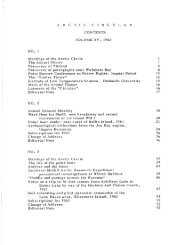Volume 4, 1951 - The Arctic Circle - Home
Volume 4, 1951 - The Arctic Circle - Home
Volume 4, 1951 - The Arctic Circle - Home
You also want an ePaper? Increase the reach of your titles
YUMPU automatically turns print PDFs into web optimized ePapers that Google loves.
<strong>The</strong> party travelled to Churchill by rail and was<br />
flown to Coral Harbour, Southampton Island, by the R.C.A.F.<br />
early in June. For the first month travel on land was<br />
hindered by the rivers which were in flood and field work<br />
was restricted to the vicinity of the settlement. Short<br />
journeys were made by dog-team on the sea ice. One of<br />
these was to the mouth of the Kirchoffer River, and a<br />
survey was made from the estuary to a point five miles<br />
above the falls.<br />
<strong>The</strong> sea ice was blown but of South Bay by a strong<br />
north wind on July 11, and both groups left Coral Harbour<br />
a week later by boat. It was originally intended that<br />
Bell and Dean would work on the Bell Peninsula for a month<br />
during which time J.B. and M.B. Bird were to survey along<br />
the east coast of the Island. <strong>The</strong> groups then intended to<br />
join for a second month on the Roes Welcome coast. To<br />
achieve this object a Peterhead boat, the Akpa was charteredl<br />
with John Ell in charge and three other Eskimo for crew.<br />
<strong>The</strong> early work went well, one group moving from Prairie<br />
Point to Native Point and on to Expectation Point, the other<br />
group surveying north from a group of Islands shown on the<br />
8 Mile Map as McMurdo Point, to Cape Fisher, Mathiassen<br />
Brook, and Cape Comfort. Trouble was experienced ~~ith sea<br />
ice in Foxe Channel, the timetable became seriously behindhand<br />
and finally on September 3, viith Frozen Strait living<br />
.up to its name, the party was forced to turn back for Coral<br />
Harbour without circumnavigating the Island. <strong>The</strong> farthest<br />
point reached was Smyth Harbour, so named by Captain G. Back<br />
in 1836, and situated between Canyon River and Cape Comfort.<br />
<strong>The</strong> highest level of marine submergence was determined<br />
to be between 550 and 600 feet above present sea level along<br />
the whole of the east coast. ln addition, evidence of high<br />
pre- or inter-glacial sea levels was discovered. <strong>The</strong><br />
archaeological sites on Bell Peninsula, particularly at<br />
Native Point, proved rich. Thule house ruins from 15 to<br />
35 feet above high tide, and Dorset middens at 85 feet were<br />
excavated. <strong>The</strong> excavations suggest that a considerable interval<br />
of time separated the Dorset and Thule occupations<br />
of these sites, and that the Thule or Sadlermiut arrived<br />
relatively late on Southampton Island.<br />
<strong>The</strong> island was at one time well populated by caribou<br />
but within fairly recent times the herds have disappeared<br />
~nd caribou are very scarce. One caribou was shot early<br />
in 1950 by an Eskimo and a number of fresh caribou tracks












